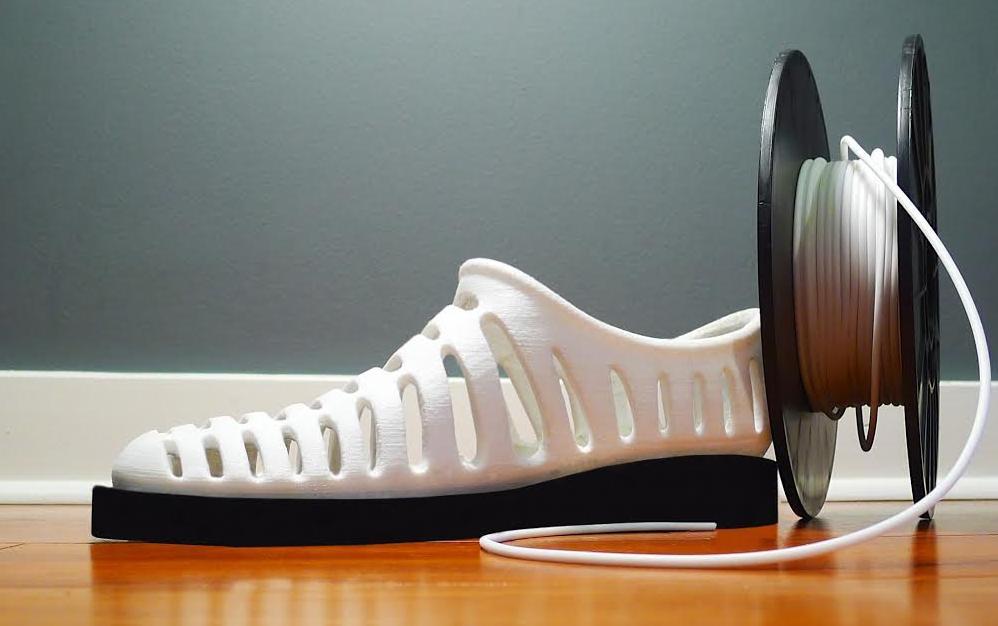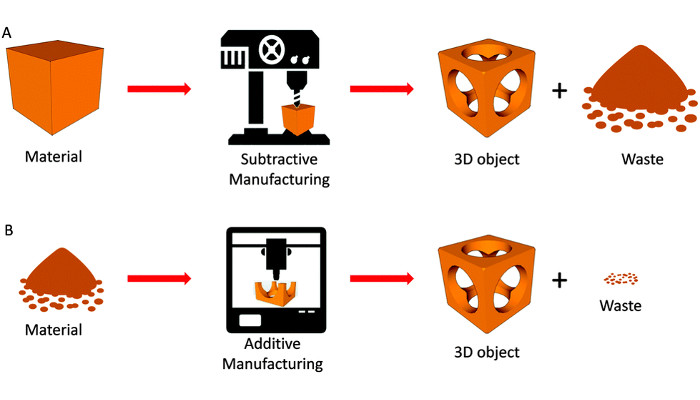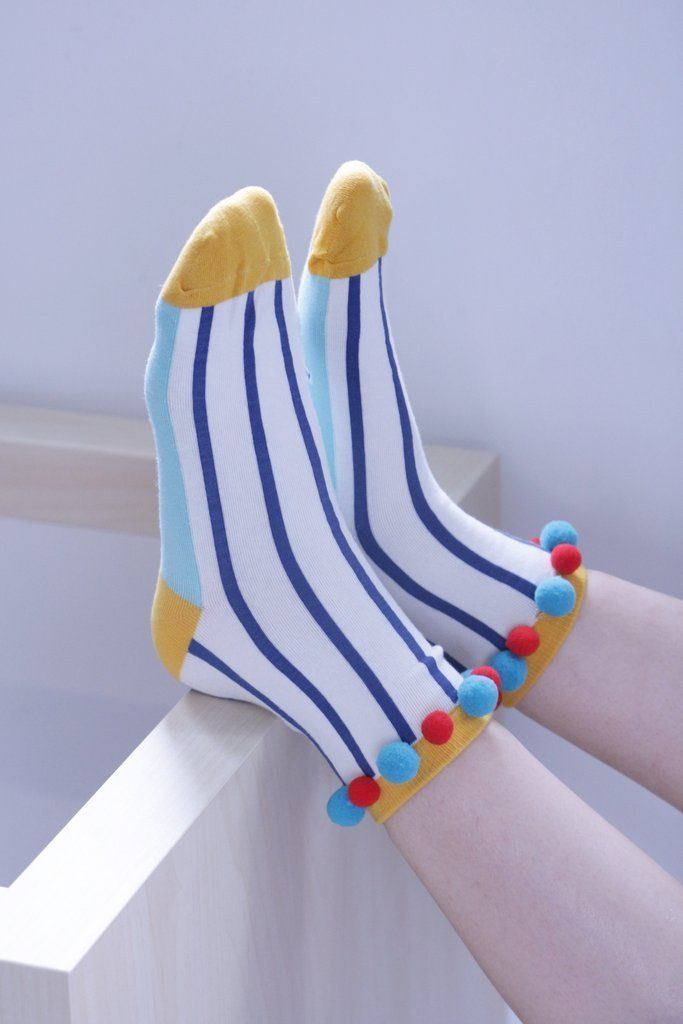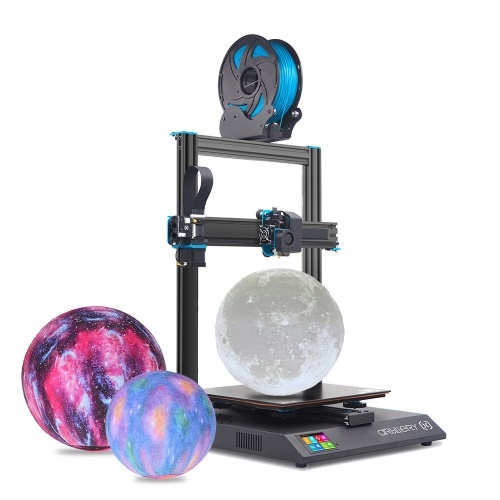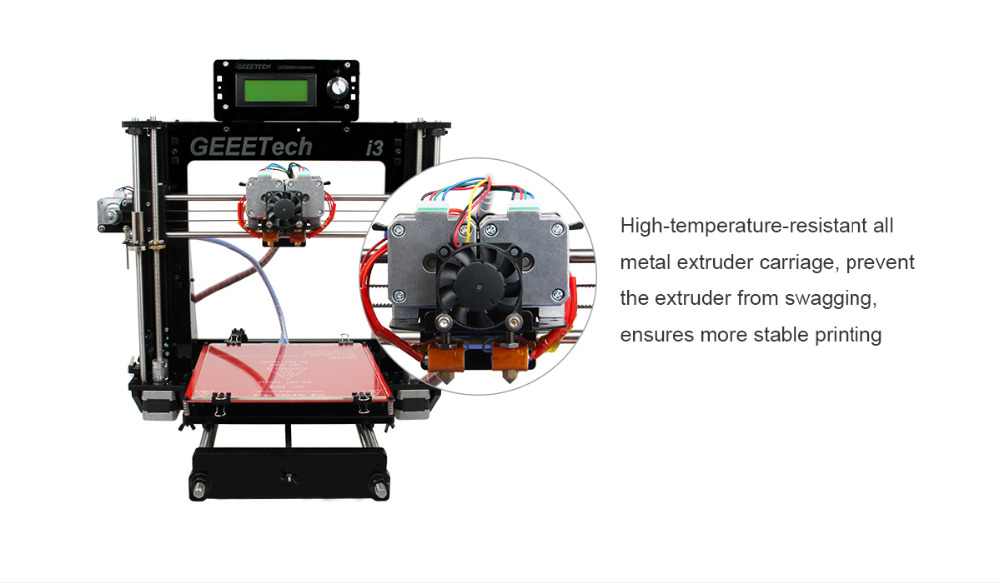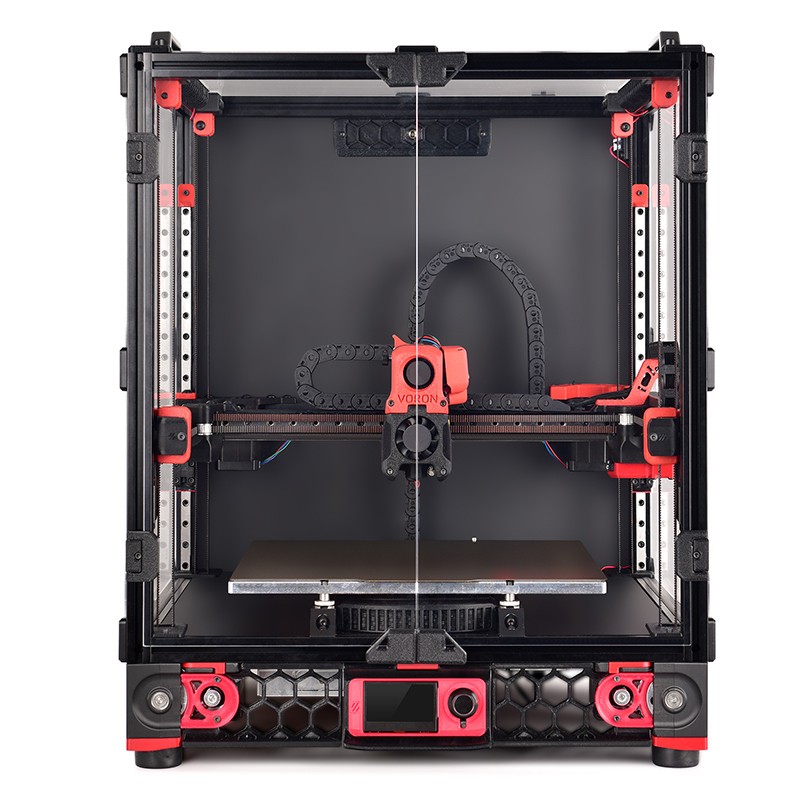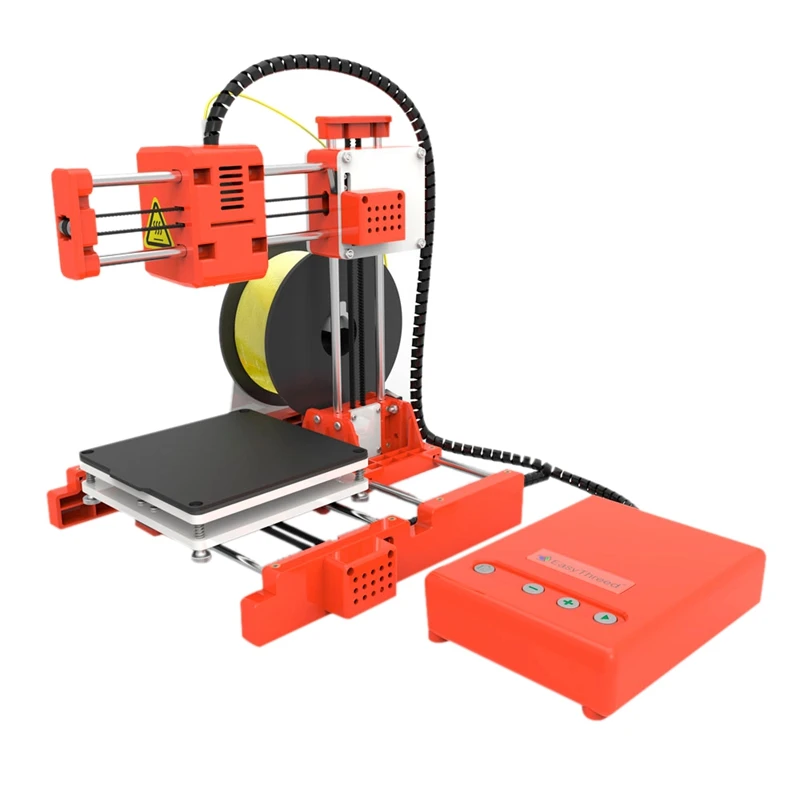Orthotics 3d printing
Why Choose 3D-Printed Orthotics? It’s All About Personalization
3D printing has come a long way since it was first commercialized over thirty years ago. It has become a go-to in many manufacturing circles, with a presence in industries such as medical, aerospace, and automotive, to name just a few. Manufacturers working under the strictest quality controls and hobbyists alike have grown to trust and rely on it because of its inherent benefits.
There are many reasons to love it — 3D printing can be cost-effective, help save time, be used to create complex structures, speed up time-to-market, and work for everything from one-off prototypes to series production.
When it comes to applications such as orthotics, some benefits stand out more than others. So, why should you choose this technology?
Make it personal
Every patient is unique. They’re built their own way, they move their own way, and they need orthotics that reflect that. This might be an issue for traditional manufacturing techniques, but not 3D printing. Because the design and printing process is entirely digital, foot and ankle experts can create a unique design, then print several pairs of orthotics simultaneously, all different from each other, making it a valid alternative for mass production.
For patients, this added level of customization lends itself to a perfect fit and happier feet with every step. That’s because every 3D printed phits orthotic begins with a CAD file, with a design based on patient data — dynamic measurements, to be precise. Instead of designing corrections based on a single scan of a patient’s foot, this technique relies on multiple, as well as gait and pressure measurements to create an average.
In doing so, foot and ankle experts can generate corrective insoles that are unique to each patient, based on their movement and the shape of their foot with greater accuracy than ever before — no more ‘one-size-fits-all’ that really fits no one — while ensuring that they remain comfortable, lightweight, and durable.
Thanks to nesting software, experts can print several unique pairs of phits simultaneously.
Accuracy and repeatability
As far as orthotics are concerned, this is a great improvement for foot and ankle experts. It allows them to build corrections into the printed base of the insole itself and apply different levels of stiffness where necessary. Unlike some traditional orthotics, this means corrective pieces are not glued on top of the insole itself, so phits are far less bulky and can be reproduced more easily.
Naturally, this improved design would be meaningless if the final product didn’t match it — but that’s no issue here. The 3D printing technique used to create phits orthotics is accurate down to 0.1mm. It would be impossible to reproduce a pair that was identical to the original by using manual techniques, and any minor differences could have a big impact on performance or patient comfort.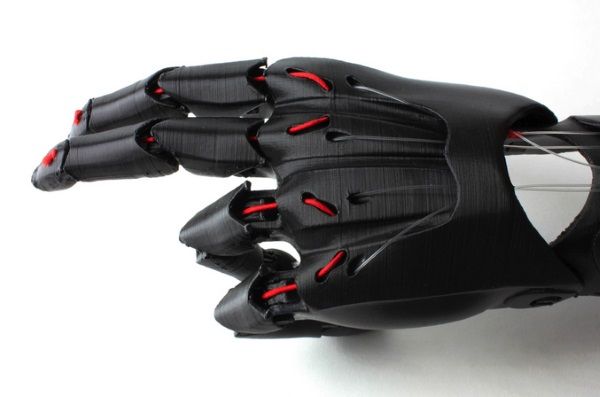 With 3D printing, they can rest assured that the result will be the same every time.
With 3D printing, they can rest assured that the result will be the same every time.
3D-printed orthotics are accurate to 0.1mm, offering enhanced repeatability.
Made with expertise
While 3D printing offers a lot of freedom, getting the most from the technology isn’t easy. It requires a deep understanding of the process, from design to execution. Manufacturers must choose from a range of different materials and 3D printing technologies, such as selective laser sintering or fused deposition modeling (FDM), depending on the desired characteristics of their final product. If a product needs to be strong and heat-resistant or flexible and porous, there’s sure to be a combination that’s perfect for the job. Knowing where and when to use each combination comes from experience.
Thankfully, more than 30 years of additive manufacturing experience has been integrated into the Materialise Phits Suite workflow.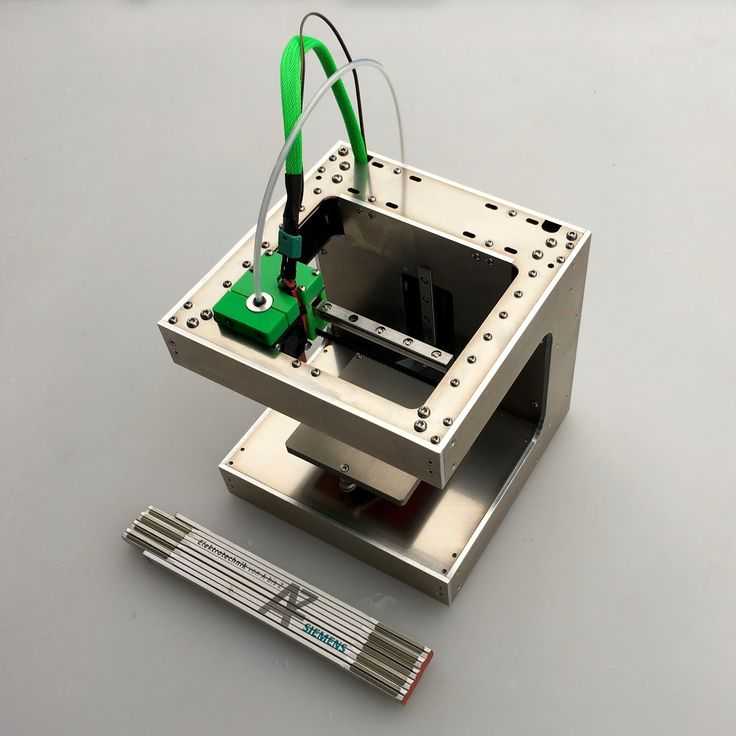 Production is handled either by our experts at Materialise or approved partners depending on region, ensuring every pair of orthotics is 3D printed and finished to the highest possible standard.
Production is handled either by our experts at Materialise or approved partners depending on region, ensuring every pair of orthotics is 3D printed and finished to the highest possible standard.
Materialise Phits Suite and 3D printing
Having 3D printing as an integral part of the Materialise Phits Suite workflow really sets it apart for foot experts. They can expect benefits that other technologies cannot offer every time they design phits orthotics for their patients, beginning with the accuracy we mentioned earlier. The final result is guaranteed to match the design down to a margin of 0.1 mm, meaning it fits the foot exactly as intended right out of the box, with less back and forth for both parties. The same can be said for any replacements they print afterward.
For Fried Vancraen, Founder and CEO of Materialise, finding that Cinderalla fit was one of the main inspirations for venturing into the world of orthotics.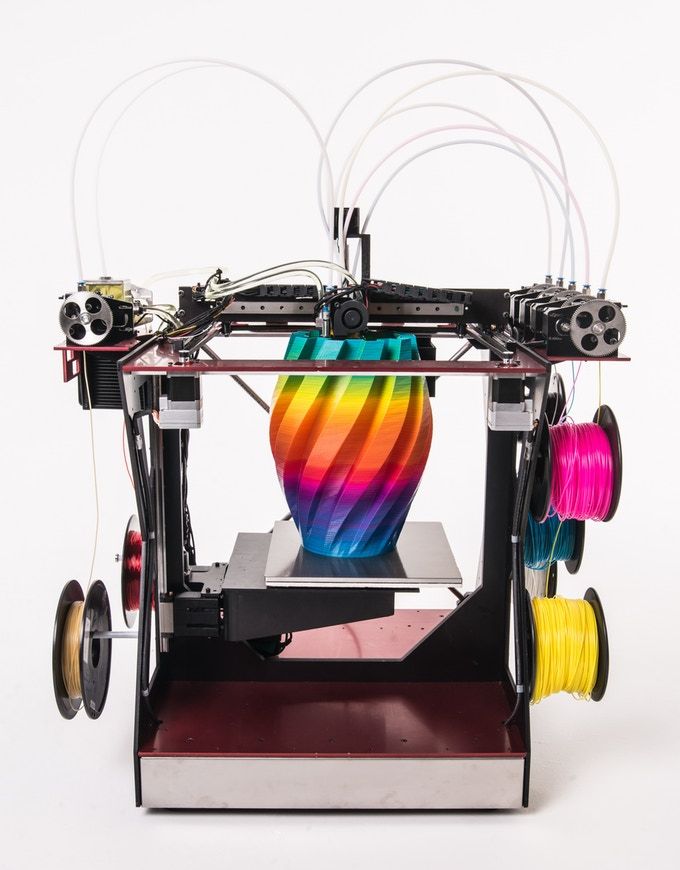 He and his children endured the time-consuming process of measuring and changing insoles every year before Materialise Phits Suite was born. Now, they’re more than happy with orthotics that fit all occasions and styles and which, thanks to the durability of 3D printing, they know will stand the test of time.
He and his children endured the time-consuming process of measuring and changing insoles every year before Materialise Phits Suite was born. Now, they’re more than happy with orthotics that fit all occasions and styles and which, thanks to the durability of 3D printing, they know will stand the test of time.
Phits orthotics will fit into many different shoes, making every situation comfortable for your patients
When asked to describe the difference between traditional orthotics and her custom-made phits, it was this durability that really stood out for marathon world record holder Paula Radcliffe:
“Well, the biggest thing is the durability. They simply don't wear out! You can keep using them, you can run a lot of miles in them, and they basically don't show much damage at all. Only the top cover wears out, and these are easily replaced. The rest, it stays there the whole time. I think it's more precise than the traditional orthotics because it's exactly the same each time it's created, and it is lighter.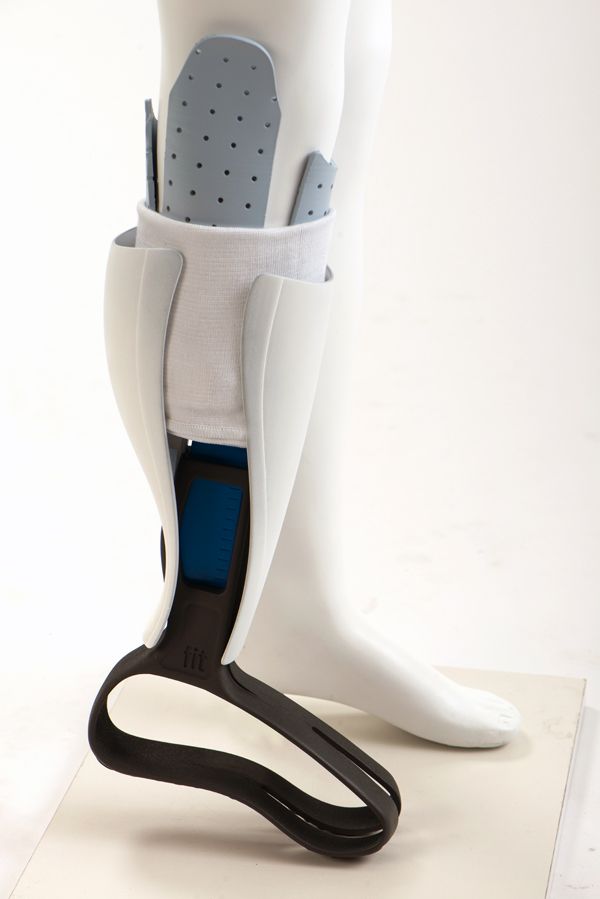 It doesn't deform with heat and get as soft as with the traditional ones. Sometimes with the older ones, if it was very warm, they would build up, or they would get a hole or deform a little bit. phits orthotics don't do that!"
It doesn't deform with heat and get as soft as with the traditional ones. Sometimes with the older ones, if it was very warm, they would build up, or they would get a hole or deform a little bit. phits orthotics don't do that!"
Making orthotics more sustainable
But there’s more to 3D printing than strength and style. Those seeking more sustainable options will also be impressed, particularly with powder-based technologies like SLS. In this case, the orthotics would be built layer by layer in a bed of powder, using only the necessary material, with waste reduced even further thanks to the use of 100% recycled powder. Whether your orthotics are printed by Materialise or by another local supplier, you’ll also benefit from simplified supply chains. Your design is made to order and shipped right to you, meaning there’s no middleman or storage necessary, further reducing the environmental impact.
Of course, none of this would matter if the process to actually create the orthotics was problematic, unreliable, or slow.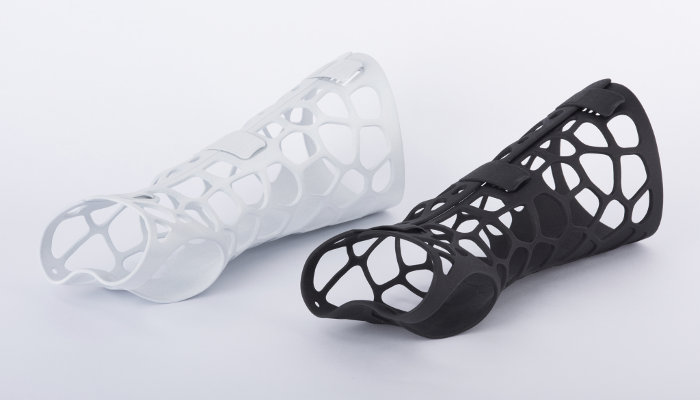 In reality, 3D printing is nothing if not convenient. As an entirely digital manufacturing process, it can be integrated seamlessly into the digital orthotic ordering workflow — the gait is measured, the orthotic is designed in the footscan software before being sent to the printers. Foot and ankle experts can handle the entire process in Materialise Phits Suite and rest easy knowing that they’ll receive exactly what they ordered.
In reality, 3D printing is nothing if not convenient. As an entirely digital manufacturing process, it can be integrated seamlessly into the digital orthotic ordering workflow — the gait is measured, the orthotic is designed in the footscan software before being sent to the printers. Foot and ankle experts can handle the entire process in Materialise Phits Suite and rest easy knowing that they’ll receive exactly what they ordered.
Say goodbye to paperwork
An added bonus of this end-to-end workflow is the clear reduction in paperwork. Because the necessary information and data is stored in the software, it has never been easier for foot and ankle experts to follow up on their patients in later appointments. Whether they need to create replacement orthotics or wish to see how an individual’s gait has changed over time, the information they need is never more than a click away.
Naturally, data security remains paramount. All patient data is securely stored in a separate, closed system, ensuring convenience doesn’t come at the expense of privacy.
Your end-users will love it, too
When patients receive their orthotics, many may not be too concerned with how they were made or where they came from. But that can change with Materialise Phits Suite. Experts can use the software’s visualizations, charts, and reports to explain the process from start to finish, including where any potential issues may stem from and how the construction of their 3D-printed orthotic can help resolve them.
With this software, experts can easily explain how and why phits will help their patients.
And there are plenty of other reasons to be happy about getting your hands on phits, starting with what matters most — comfort. Those who wear them, like British marathon champion Charlotte Purdue, quickly notice the difference that having orthotics shaped to fit their foot will have on how they move.
“When I first wore them, I found that they fit well, and I didn’t have any problems with them,” says Charlotte.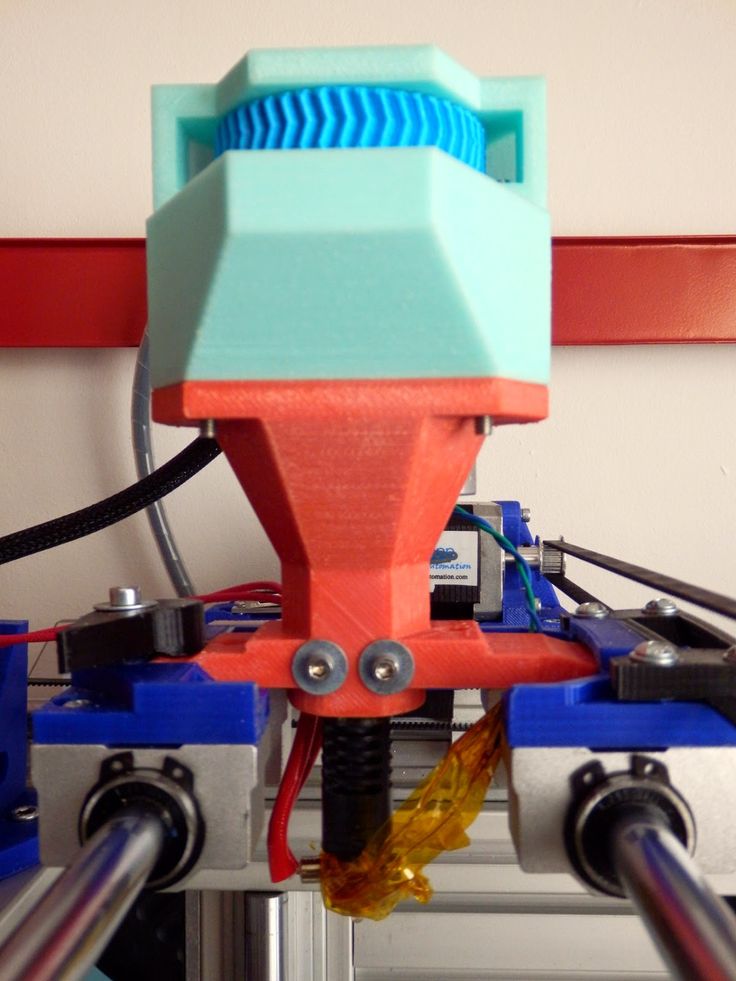 “They fit my running style completely. If they didn’t, I’d have had blisters, or it wouldn’t feel right, but it felt like they needed to be in my shoes.”
“They fit my running style completely. If they didn’t, I’d have had blisters, or it wouldn’t feel right, but it felt like they needed to be in my shoes.”
Thankfully, an insistence on comfort doesn’t mean compromising on durability or performance. Because of their high-quality materials and engineered design, 3D-printed orthotics like phits are both lightweight and strong, meaning they’ll endure heavy usage for years and weigh about half as much as traditional, milled insoles. The soft, comfortable top cover is easily replaced when wear and tear kicks in, extending the life cycle even further, meaning phits aren’t just good for the environment but for the wallet, as well.
Athletes like Charlotte Purdue use phits every day, but they’re also great for day-to-day activities.
A big step forward for orthotics
Much like the analysis and design of orthotics has come far in recent years — it wasn’t long ago that foam boxes were the only available option — the introduction of 3D printing into the workflow is doing a lot to drive the industry forward to the benefit of everyone. It’s a big step forward for those who design orthotics and an even bigger step for those who wear them.
It’s a big step forward for those who design orthotics and an even bigger step for those who wear them.
Materialise Phits Suite makes sure taking it has never been easier.
Top 3D Printed Orthoses - 3Dnatives
Published on December 2, 2022 by Carlota V.
It is becoming increasingly evident that additive manufacturing has a pivotal role to play within the medical sector. This is largely due to the ability to create and customize solutions tailored to each individual. From bioprinting projects for tissue development to medical devices such as 3D printed implants, prostheses or orthoses. The latter, unlike 3D printed prostheses, have the function of medical supports that help modify and restore functional aspects of the neuromusculoskeletal system. Thus, orthoses are able to stabilize, relieve, immobilize, guide or correct a damaged part of the body. Since the morphology of each patient is different, the use of 3D printing is ideal for designing these unique devices adapted to each patient.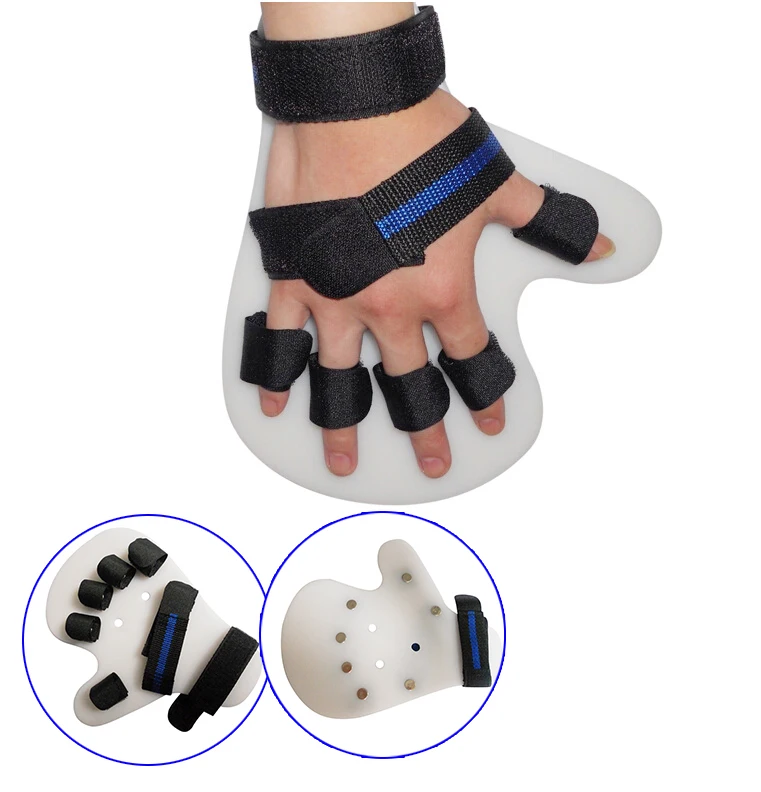 Therefore, on this occasion we wanted to compile some of the most outstanding orthosis projects to date.
Therefore, on this occasion we wanted to compile some of the most outstanding orthosis projects to date.
POHLIG GmbH’s SimBrace Technology
Pohlig is a manufacturer of orthotics for different parts of the body. Whether it is for a hand, a leg or even the chest, the company has a wide range of choices for its customers. In addition, Pohlig has created the SimBrace technology. This innovation is a 3D scanning process developed for patients. It adjusts the shape and position of the brace according to the patient’s morphology. The part is then 3D printed with FDM technology for prototypes, while the final products will use powder sintering. Once the part is given to the patient, the company accompanies them to improve their adaptation with the orthosis, especially for the legs.
Photo credit: Pohlig GmbH
OT4 Orthopädietechnik
OT4 Orthopädietechnik is a German company that is part of the Streifeneder Group. It specializes in the manufacture of patient-specific orthotics. Each component is designed using modern tools, including Multi Jet Fusion technology. This printing process allows for the production of custom-made products and easy modifications. OT4 Orthopädietechnik designs devices for various parts of the body: the face, head, arms and joints. The technology used offers advantages in terms of weight, quality and reproducibility. Together with its partner craft companies, the company combines the strengths of craftsmanship and digital manufacturing to create reliable products.
Each component is designed using modern tools, including Multi Jet Fusion technology. This printing process allows for the production of custom-made products and easy modifications. OT4 Orthopädietechnik designs devices for various parts of the body: the face, head, arms and joints. The technology used offers advantages in terms of weight, quality and reproducibility. Together with its partner craft companies, the company combines the strengths of craftsmanship and digital manufacturing to create reliable products.
Photo credit: OT4 Orthopädietechnik
Custom-made Orthotics with Chabloz Orthopedics
Chabloz Orthopedics is a French company specializing in the design and production of custom-made orthotics for upper and lower limbs. Among the 3D printed parts, it manufactures helmets to fight against plagiocephaly, a skull deformity in infants. In addition, Chabloz Orthopedics differentiates between two types of orthoses for the lower limbs: posture orthoses and walking orthoses. The first is used to compensate for a disability of the lower limb, while the second can be used in addition to walking aids to improve the fluidity of the joints. The company uses HP Multi Jet Fusion printers to accelerate the manufacturing process.
The first is used to compensate for a disability of the lower limb, while the second can be used in addition to walking aids to improve the fluidity of the joints. The company uses HP Multi Jet Fusion printers to accelerate the manufacturing process.
Photo credit: Chablaz Orthopaedics
ScientiFeet, making 3D printed insoles
ScientiFeet is a French solution, created in January 2016 by PODO 3D (itself a subsidiary of Prodways group, a French 3D printing company), and is one of the leaders in the production of 3D printed insoles. Their solution is intended for practitioners to provide a personalised and unique product to patients. Thanks to their 3D scanner, they are able to create a very precise and custom 3D footprint which provides a high-degree of accuracy and completely new production possibilities at a better cost. The process takes just 4 steps: first, the podiatrist takes a scan of the foot using the Podoclic 3D scanner. Then, they model the scan on the Scientifeet software, which is then used to design 3D soles. These soles are designed with a specific size, thickness and arch height in mind. They are outsourced to the Prodways fleet of printers, which print them in PA12 material; the finished product is delivered to the practitioner’s office in just 5 days. Furthermore, the Scientifeet solution can also be installed in practitioners” offices, with Scientifeet offering expert advice and periodic training on the equipment.
These soles are designed with a specific size, thickness and arch height in mind. They are outsourced to the Prodways fleet of printers, which print them in PA12 material; the finished product is delivered to the practitioner’s office in just 5 days. Furthermore, the Scientifeet solution can also be installed in practitioners” offices, with Scientifeet offering expert advice and periodic training on the equipment.
Photo credit: ScientiFeet
Invent Medical, Custom-made Orthotics for Sport and More
Invent Medical is a UK-based firm which has been successfully 3D printing since 2010 to offer solutions for the orthotic and prosthetic field. They cooperate with doctors, clinicians and universities to offer durable and attractive solutions. They offer cranial remoulding helmets (as in the image below), ankle foot orthosis, prosthetic sockets, insoles and face masks, and future projects will include arm and adult orthoses. The uses for these products include sport injuries, prosthetic limbs and to treat abnormalities.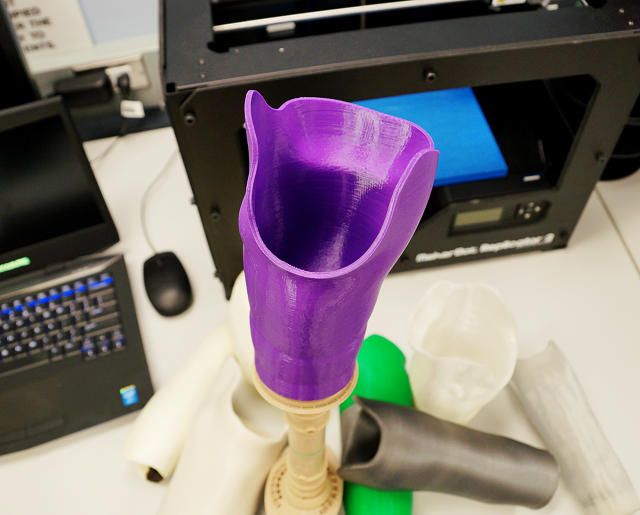 Their Invent Medical Configurator is an easy to use software tool that helps you design your orthotic and prosthetic product in a matter of minutes. Then, using 3D and 2D scanners, they ensure that the product fits the patient perfectly before sending the data to a HP industrial printer for 3D printing. Their products are comfortable and aesthetically pleasing, as well as being custom-made to each product.
Their Invent Medical Configurator is an easy to use software tool that helps you design your orthotic and prosthetic product in a matter of minutes. Then, using 3D and 2D scanners, they ensure that the product fits the patient perfectly before sending the data to a HP industrial printer for 3D printing. Their products are comfortable and aesthetically pleasing, as well as being custom-made to each product.
Photo credit: Invent Medical
Xkelet Scans and 3D Prints Orthoses
The Spanish company Xkelet has developed a system capable of scanning and manufacturing orthoses adapted to the morphology and needs of each patient. These allow the immobilization of the upper and lower extremities to solve the problems derived from traditional systems such as plaster, fiberglass, thermoplastics and orthopedic products. In particular, they have an application for cell phones that allows them to obtain data and 3D scan the design of the orthosis in a matter of seconds. Then, thanks to their partnership with Photocentric, they can use resin 3D printing to create customized orthoses on demand. This results in a unique orthosis that is much lighter than traditional plaster options. You can see the live scan solution below:
This results in a unique orthosis that is much lighter than traditional plaster options. You can see the live scan solution below:
Korthotics Nylon Orthoses
Korthotics is a Sydney-based provider of orthotic solutions, with 40+ years of experience in making and delivering custom orthoses. They offer a range of products made using their 3D Systems ProX SLS 6100 Printer, an industrial grade SLS printer; their material of choice is nylon-11. Nylon is absorbent, strong, and lightweight, which allows them to create high-quality products with minimal waste. These products include custom-made orthoses including feet, cranial helmets, knee braces, and ankle-foot orthoses. All of these products are manufactured at their facility in Sydney. Outside of 3D printing, their DM Orthotics (DMO®) brand offers elastomeric fabric orthoses for a range of conditions including cerebral palsy, scoliosis, strokes and Downs Syndrome, among others.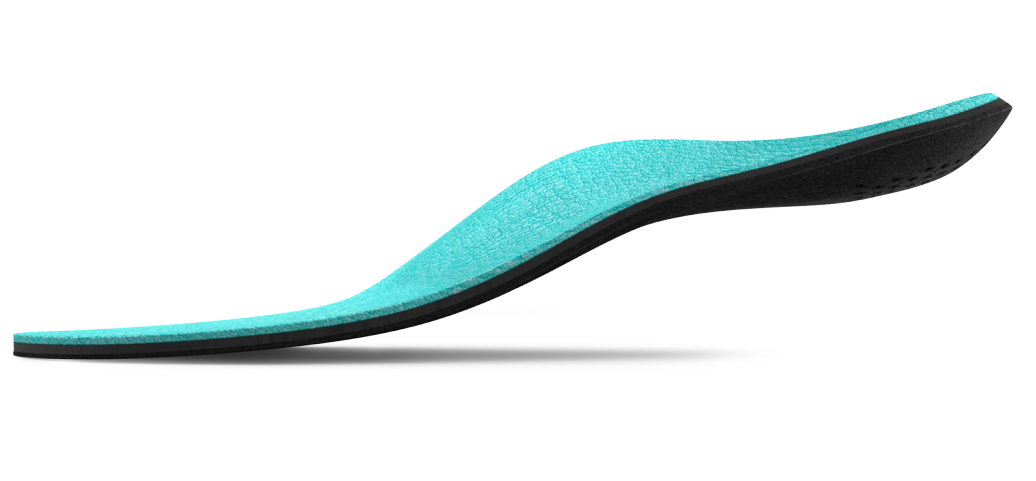
Korthotics offers a range of custom 3D printed solutions. (Photo credit: Korthotics)
Think3DDD: For People And Animals
Berlin-based Think3DDD, founded by Tino Jacobi and Leonardo Lauer, focus on orthotics for humans as well as animals. With their 3D-printed solution, called Orthimale, the Think3DDD team wanted their orthosis to primarily combat problems such as a heavy cast, itching and annoying sutures. Here’s how it’s made: After the 3D scan via smartphone of the body part for which the orthosis is intended, it is created in collaboration with the treating physician, tested and 3D-printed using the FFF process. Once the treatment is finished, the orthosis is either recycled or even composted by Think3DDD, so there is no additional environmental impact.
Photo credit: Think3DDD
Wypro Makes Orthopaedic Insoles
Wypro, run by Dr. Pablo Marin, a podiatrist specialized in mechanics and also CEO of the company, has focused on the production of orthopaedic insoles since their foundation in 2019.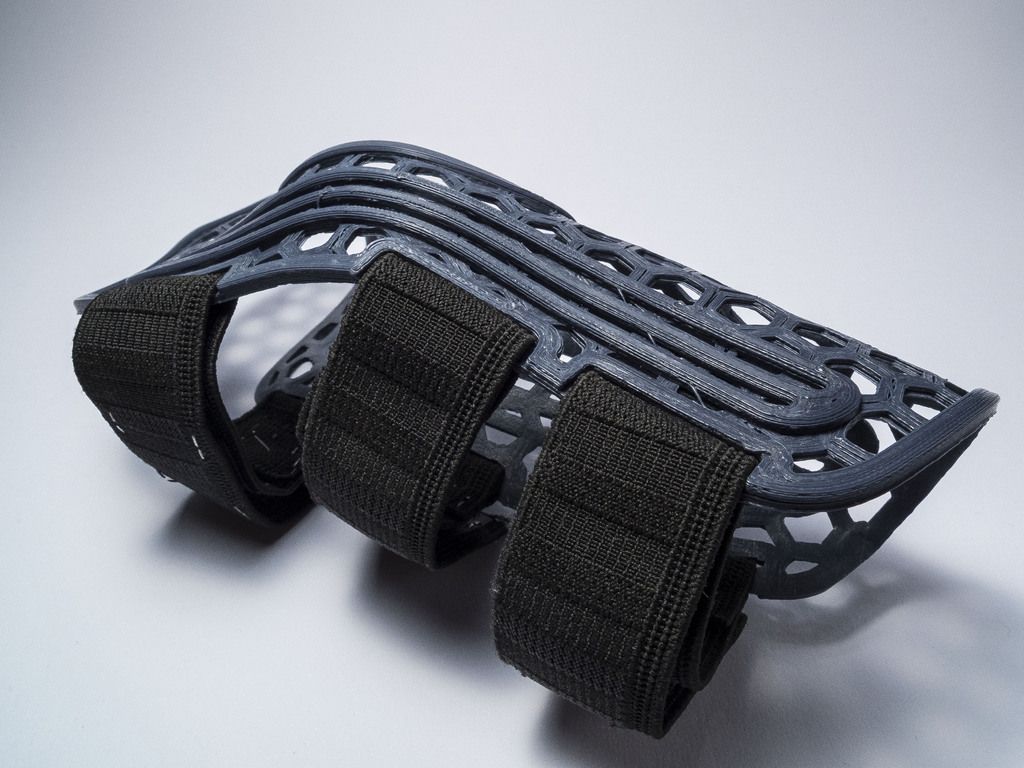 For this, Wypro uses a 3D laser scanner that they developed in 2017 for the podiatry and orthopaedics sector. The advantages that the Spanish company sees in this are, on the one hand, speed and accuracy, but on the other hand, the fact that the professional can correct the foot before the scan and place it in an optimal position. Once the 3D scan has been made, it is then printed for the orthopaedic insole using the SLS process.
For this, Wypro uses a 3D laser scanner that they developed in 2017 for the podiatry and orthopaedics sector. The advantages that the Spanish company sees in this are, on the one hand, speed and accuracy, but on the other hand, the fact that the professional can correct the foot before the scan and place it in an optimal position. Once the 3D scan has been made, it is then printed for the orthopaedic insole using the SLS process.
Photo credit: Wypro
WASP Back Corset
Who among us has not heard of scoliosis? The sideways curvature of the spine is often diagnosed in children or adolescents and can be debilitating if it is not treated properly before growth. Indeed, it is estimated to affect about 2-3 percent of the population of the world, with an estimated six to nine million people in the United States alone. But the treatment is often an uncomfortable and expensive orthopaedic corset. Luckily, 3D printing could provide a better solution. Lelio Leoncini, along with Italian 3D printing company WASP, has created 3D printed corsets, made out of polypropylene, which can provide solutions for even serious cases, such as patients who need busts with a complex shape or head support in addition to the bust. They also offer the possibility to design in 360° in order to create tailor-made solutions, allowing for all kinds of shapes including for children with breathing or walking difficulties.
They also offer the possibility to design in 360° in order to create tailor-made solutions, allowing for all kinds of shapes including for children with breathing or walking difficulties.
Photo credit: WASP
ActivArmor Offers Waterproof, 3D Printed Casts and Splints
One of the most common orthotics that we see out in the world are of course casts and splints. For anyone who may have broken a bone, these heavy and inconvenient casts can be a true burden while you are healing. Luckily, they are not the only option. American company ActivArmor offers 3D printed, waterproof, breathable, sanitizable plastic casts which allow users to maintain their active lifestyles while staying safe. Currently, not only is ActivArmor the only commercially available, 3D printed custom splint in the USA, but it is listed with the FDA as a Class 1 splint as well as ISO-10993 certified for biocompatibility.
Was this ranking on 3D printed orthoses useful? Which is your favorite? Let us know in a comment below or on our LinkedIn, Facebook, and Twitter pages! Don’t forget to sign up for our free weekly Newsletter here, the latest 3D printing news straight to your inbox! You can also find all our videos on our YouTube channel.
Process of making orthopedic insoles using the Raise3D printer
3D printing is a versatile form of additive manufacturing that is gaining popularity in a variety of fields. Currently, it is increasingly being used in plastic surgery and in the creation of orthopedic medical products and equipment. 3D printing has come to be used to improve medical devices due to the production stability and time efficiency it provides. An example of such an application can be seen in the collaboration between the Italian company CREA3D and the orthopedist Dr. Valenti. They are successfully combining 3D printing with other digital technologies to produce customized insoles and other custom-designed orthotics, thus enhancing the effectiveness of assistive care.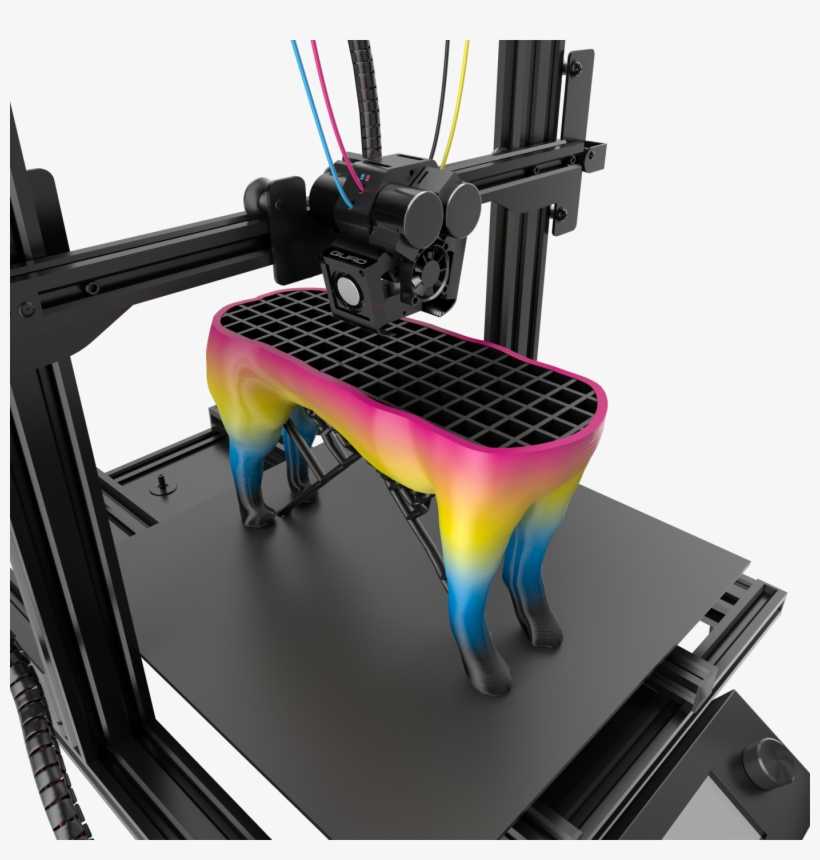 nine0003
nine0003
Dr. Mirko Valenti used 3D printing technology to treat clinical cases of tibialis posterior tenosynovitis with conservative corrective therapy. The introduction of technology into the treatment process was both innovative and highly effective. Valenti purchased a Raise3D E2 3D printer equipped with IDEX technology (independent dual extruder) for his office. The Raise3D E2 is ideal for printing a pair of orthopedic insoles at the same time.
Individual orthopedic insoles
Traditional manufacturing of insoles before 3D printing
Each pair of orthopedic insoles is individual for a particular patient, because everyone has their own needs. The strength properties of the various parts of the insoles must be adjusted according to individual characteristics.
This proved to be a problem for the traditional manufacturing process. The traditional process requires using a CNC machine to mill a piece of material into the desired shape.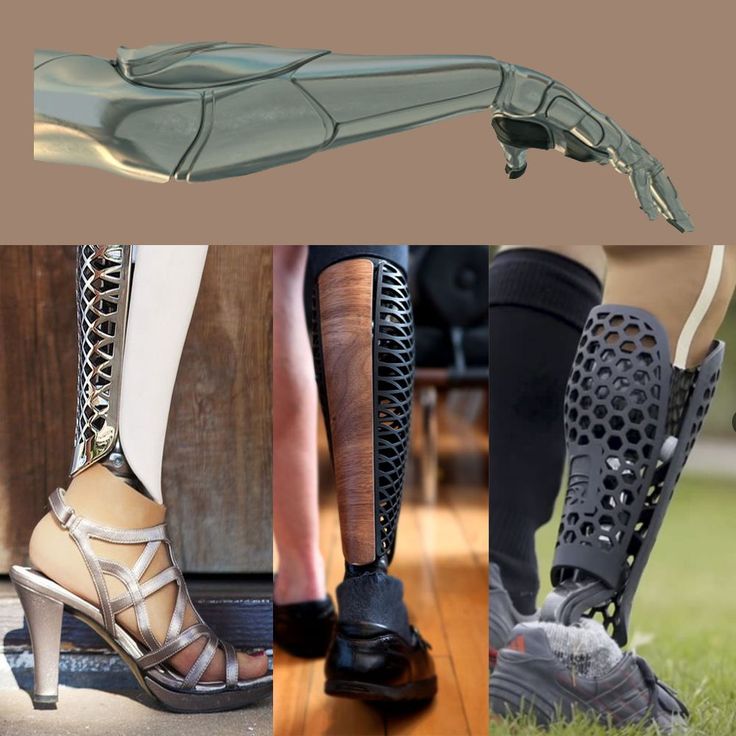 To ensure the accuracy of the anatomical region in the insole, a high-precision CNC machine and high labor costs are required. This is a laborious and complex process. The production process creates a lot of garbage and dust, pollutes the working environment, endangers the health of workers. nine0003
To ensure the accuracy of the anatomical region in the insole, a high-precision CNC machine and high labor costs are required. This is a laborious and complex process. The production process creates a lot of garbage and dust, pollutes the working environment, endangers the health of workers. nine0003
Manufacture of insoles after the advent of 3D printing
Abandoning traditional CAD-CAM machines, Dr. Mirko Valenti began to print orthopedic insoles with PP plastic thread. Due to the durability and strength of the material, excellent support for the patient's foot is provided. Printing a pair of orthopedic insoles with PP thread is a simple process.
First, the doctor scans the patient's leg. He then uses a CAD program to make a model of an orthopedic insole with compensating supports for the affected areas, thereby ensuring that the arch of the foot is supported and the heel is stable. Valenti then loads the model file into ideaMaker 3D print preparation software to optimize technical properties such as shape change and infill percentage of the model. For example, honeycomb infill can make the structure rigid. The filling allows different results in terms of deformability and softness of the orthosis. Then the doctor uploads the model file to the E2 3D printer, which prints out a pair of insoles at the same time. Finally, Dr. Valenti wraps the sole with EVA or other special materials suitable for skin contact. nine0003
For example, honeycomb infill can make the structure rigid. The filling allows different results in terms of deformability and softness of the orthosis. Then the doctor uploads the model file to the E2 3D printer, which prints out a pair of insoles at the same time. Finally, Dr. Valenti wraps the sole with EVA or other special materials suitable for skin contact. nine0003
The entire manufacturing process, including scanning, design and production, takes less than 24 hours.
Benefits of 3D oven orthopedic insoles;
3D printing simplifies the traditional process and shortens the production cycle, as well as the time it takes for the customer to receive the product. A 3D printed model can be produced in a single process without the use of any other additional machines and tools. Printing a pair of orthopedic insoles on the Raise3D E2 printer takes only 2-3 hours, and the whole process is done automatically without the need for manual control. Making insoles without 3D printing requires a lot of hand tools, a lot of time to get an accurate model according to the anatomical features. 3D printing makes it possible to successfully carry out individual orthopedic treatment. nine0003
3D printing makes it possible to successfully carry out individual orthopedic treatment. nine0003
3D printing is an efficient manufacturing process
3D printing is a more efficient process for producing insoles. Users can design models and mass-produce them at the same time. With 3D printing, there is no need for multiple design, verification, and modification processes. 3D printing makes it possible to produce small batches on demand. The model is available immediately.
Enclosed 3D printers provide a greener working environment
Enclosed 3D printers like the Raise3D filter out any fumes that are released when the material is heated during 3D printing. This reduces the need for large workshops or separate production rooms. As a result, 3D printing provides a cleaner and healthier environment. You can perform mass production right in the office.
Correct software for 3D printing
Dr. Valenti chose polypropylene as the material for the 3D printing to provide support and flexibility for various insoles. Each kind of polymer needs different settings. The right software can greatly simplify the job of customizing settings. nine0003
Each kind of polymer needs different settings. The right software can greatly simplify the job of customizing settings. nine0003
For example, ideaMaker is a file-to-print software that has many built-in preset templates for various polymers (including polypropylene).
The main advantage is that users can adjust internal structure parameters such as infill density, infill angle, and others to control strength properties.
Adjust the model properties in ideaMaker to prepare the model for printing. nine0011
Raise3D provides a complete process for the production of orthopedic insoles
Dr. Valenti chose the Raise3D E2 desktop 3D printer for the production of orthopedic insoles. As a medium-sized professional desktop printer, the E2 meets all print quality requirements. At the same time, E2 is suitable for home and small studios. IDEX E2 technology allows users to print a pair of orthopedic insoles at once, maximizing production efficiency.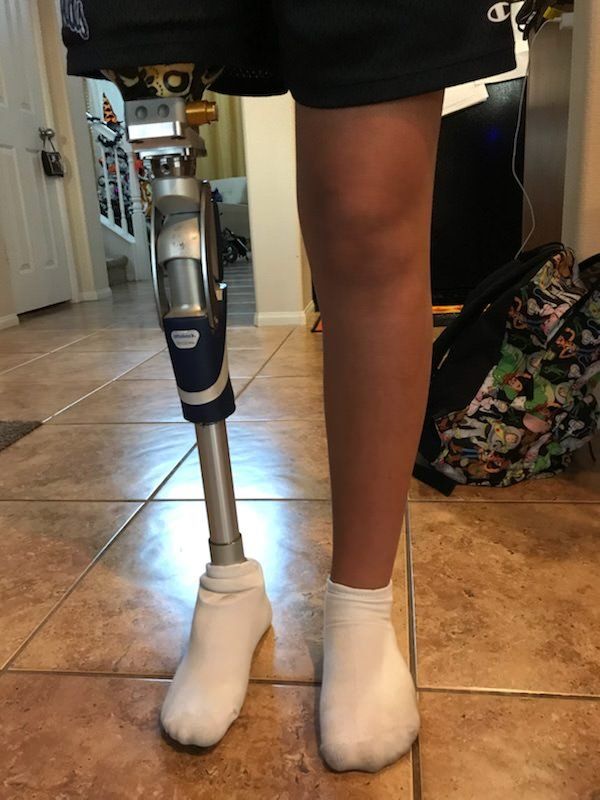 In addition, during the manufacturing process, Dr. Valenti uses ideaMaker 3D printing file preparation software to reinforce the internal structure of the insole. ideaMaker has parameter settings and various templates, allows you to customize and change the technical properties of the insole. The E2 desktop 3D printer supports a variety of plastics, including polypropylene. Users can learn about polymer characteristics and download related files. nine0003
In addition, during the manufacturing process, Dr. Valenti uses ideaMaker 3D printing file preparation software to reinforce the internal structure of the insole. ideaMaker has parameter settings and various templates, allows you to customize and change the technical properties of the insole. The E2 desktop 3D printer supports a variety of plastics, including polypropylene. Users can learn about polymer characteristics and download related files. nine0003
3D printing will benefit more medical fields
3D printing provides better customization, precision, aesthetic appearance and lightweight structure. It also significantly reduces the manufacturing process and lead times and fabrication. Dr. Mirko Valenti used 3D printing in the manufacture of plantar orthoses. He used Raise3D printers and software for a full production cycle and achieved high efficiency thanks to the Raise3D ecosystem. nine0003
The material is provided by the Italian distributor of Raise3D - Crea3D.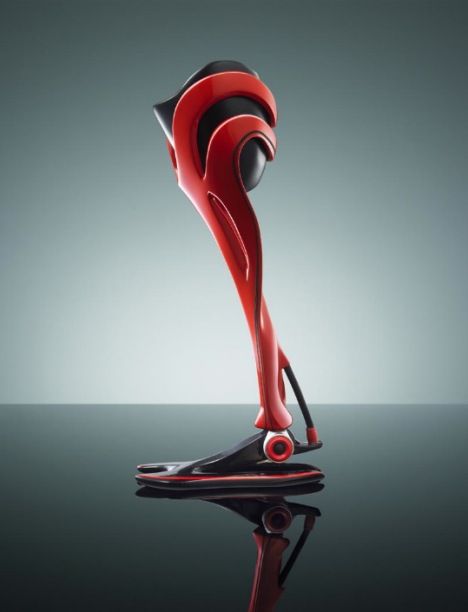
3D printed orthotics
05/20/2020
3D printing in orthopedics has been used quite recently. And although the share of its application in this industry is still very small and cannot be compared, for example, with dentistry, the development has already begun and there is no point in denying the effectiveness of a 3D printer in the manufacture of orthopedic products.
Orthopedic products are a fairly broad concept, they can be temporary or permanent wear products used to support, stabilize and rehabilitate injured limbs, such as orthoses, splints, corsets, insoles, etc. nine0003
For maximum effectiveness, orthopedic devices are most often made to measure. Traditional production methods are quite labor intensive and require fitting, fitting, which consumes a lot of time and materials.
Due to their affordability and ease of use, 3D scanning and 3D printing have greatly simplified the entire process of manufacturing custom orthotics.
nine0087 Insoles
Orthopedic insoles are used for non-surgical correction of foot and ankle problems, as well as to improve the athletic performance of professional athletes. The grueling taking of impressions and the lengthy production time are a thing of the past decade.
Now, to make an orthopedic insole, you only need an orthopedic 3D scanner, a 3D printer, and 6-10 hours to get the finished product. nine0003
Orthoses
Those who have ever broken an arm, leg or finger know what kind of agony a plaster orthosis delivers. A custom 3D printed plastic orthosis easily replaces a cast for mild to moderate injuries. At the same time, it breathes completely, does not irritate the skin and does not interfere with hygiene procedures.
Corsets
An orthopedic corset is a more complex product, and requires the most accurate fit to the patient's figure.